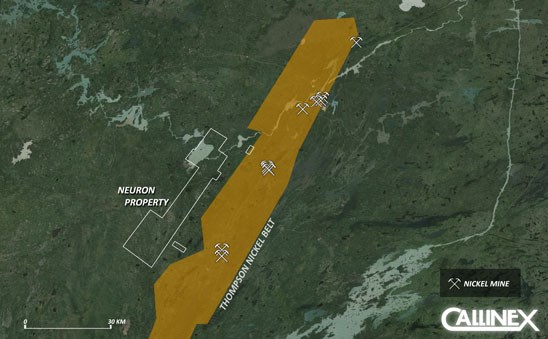Callinex Mines' winter drilling has intersected nearly 80 metres of graphite mineralization at its Neuron property, located to the west of the Thompson Nickel Belt, says Braden Maccke, a long-time investor relations spokesman for the Vancouver junior mining company.
The Thompson Nickel Belt is a narrow band of rock trending southwest and northeast of Thompson, squeezed between two major blocks, known as the Churchill and Superior provinces of the Canadian or Precambrian Shield. The rock comprising the belt was formed by massive pressure and is rich in nickel, copper an other mineral deposits.
Callinex Mines, known as Callinan Mines until 2011, by staking in 2013, acquired the Neuron property. In January, Callinex received final title from the Manitoba Department of Mineral Resources for the 17,500 hectares of Mineral Exploration Licenses in Northern Manitoba it had previously applied for. The approval brought the land package in the district to a total of 44,300 hectares in area. Callinex is the sole holder of the Mineral Exploration Licences, and several additional mineral claims.
Canadian exploration geologist Mike Muzylowski, who heads Callinex Mines, as chairman of the board of directors and chief executive officer, is a veteran of the Canadian mining industry, and a member of the Canadian Mining Hall of Fame. Muzylowski was the 1988 recipient of the Prospectors and Developers Association of Canada Developer of the Year Award in recognition of the some 17 ore bodies in which he was involved in discovering, 13 of which are in Manitoba.
He joined Hudson Bay Exploration and Development Co. Ltd. in 1955 and held various positions including chief geophysicist, senior project geologist and assistant superintendent of exploration and development. From 1970 to 1984, he was a senior executive for Granges Exploration overseeing the eventual sale of the company to MIM, and was the discoverer of the Trout Lake Ore body at Flin Flon, which has been in continuous production since 1984.
In 1916, Jack Callinan staked mineral claims in present day Flin Flon. Trenching and drilling conducted between 1927 and 1929 defined and began the Callinan Mine which operated until the massive, high-grade 777 zinc, copper, gold and silver mine was discovered adjacent to it and put in to production by HudBay Minerals Inc. in 2004. The company that Callinan founded, now Callinan Royalties, still owns and controls a royalty in the 777 deposit, and the ground that surrounds it, Callinex Mines Inc. says on its website. The current expected mine life for the 777 Mine is seven more years until 2021, HudBay Minerals Inc. says.
"Our exploration program has been going on for almost a month now," Maccke told the Nickel Belt News in a March 24 e-mail. "Initial results are very encouraging with nearly 80 metres of graphite mineralization encountered in the discovery hole. We are anticipating assay results that will determine both flake size and carbon content. The drilling program is ongoing.
"The company feels that there is an enormous amount of potential growth in the graphite sector. Graphite is used in steel crucibles, and its use in lithium ion batteries is expanding (most notably through new automobile applications being popularized at Tesla Motors). Increasingly, the new-materials, nano-materials and 3D printing spaces are working with graphite to produce next-generation materials like graphene and carbon nano-tubes," said Maccke.
Two diamond drill holes have been completed at the company's Neuron property.
"Graphitic horizons were observed visually and occur from surface to depths of 80 metres," the company said in a March 14 news release. "Within the 0-80 metre intersections two notable near solid graphite intervals ranging from 0.5 metres to 3 metres have been identified in both drill holes. The near solid graphite zones are preceded and followed by wispy graphite mineralization throughout the host rock (quartz-bitotite schist). Logging and sampling of drill core was completed at a company facility. Samples are being sent in batches to SGS Labs in Lakefield, Ontario. There, core will undergo testing to determine the content of graphitic carbon, as well as grain size and liberation characteristics."
The initial round of drilling is testing electromagnetic (EM) targets identified by an airborne Versatile Time-Domain Electro Magnetics (VTEM) survey conducted during the fall of 2013.




